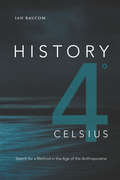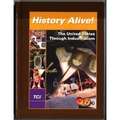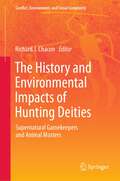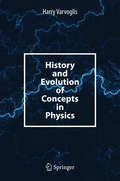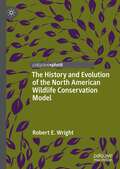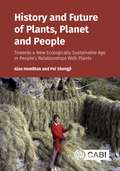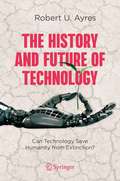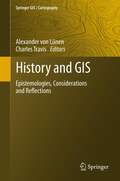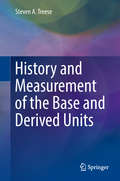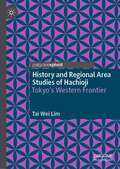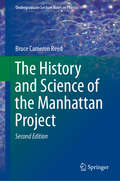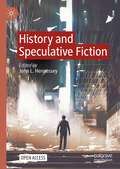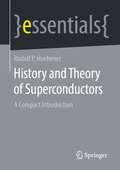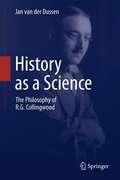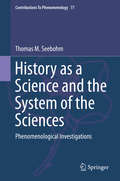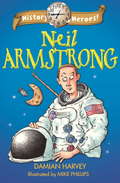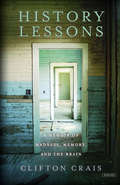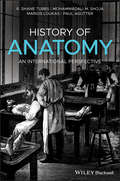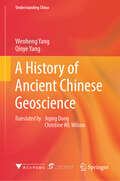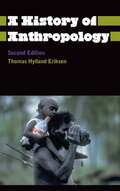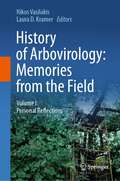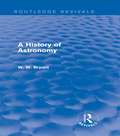- Table View
- List View
History 4° Celsius: Search for a Method in the Age of the Anthropocene (Theory in Forms)
by Ian BaucomIn History 4° Celsius Ian Baucom continues his inquiries into the place of the Black Atlantic in the making of the modern and postmodern world. Putting black studies into conversation with climate change, Baucom outlines how the ongoing concerns of critical race, diaspora, and postcolonial studies are crucial to understanding the Anthropocene. He draws on materialist and postmaterialist thought, Sartre, and the science of climate change to trace the ways in which evolving political, cultural, and natural history converge to shape a globally destructive force. Identifying the quest for limitless financial gain as the primary driving force behind both the slave trade and the continuing increase in global greenhouse gas emissions, Baucom demonstrates that climate change and the conditions of the Black Atlantic, colonialism, and the postcolony are fundamentally entwined. In so doing, he argues for the necessity of establishing a method of critical exchange between climate science, black studies, and the surrounding theoretical inquiries of humanism and posthumanism.
History Alive! The United States Through Industrialism
by Teachers' Curriculum InstituteHistory Alive! has literacy instruction built into the Student Text, Interactive Science Notebook, and Lesson Presentations. The following six key points emphasizes integration of literacy and language arts practices. They are particularly important in social studies instruction.
The History and Environmental Impacts of Hunting Deities: Supernatural Gamekeepers and Animal Masters (Conflict, Environment, and Social Complexity)
by Richard J. ChaconThis edited volume analyzes the belief in supernatural gamekeepers and/or animal masters of wildlife from a cross-cultural perspective. It documents the antiquity and widespread occurrence of the belief in supernatural gamekeepers at the global level. This interdisciplinary volume documents both the antiquity and the widespread geographical distribution of this belief along with surveying the various manifestations of this cosmology by way of studies from Europe, Asia, Africa, and North and South America. Some chapters explore the manifestations of this belief as they appear in petroglyphs/pictographs and other forms of material culture. Others focus on the environmental impacts of these beliefs/rituals and prescribed foraging restrictions by analyzing how they affect game harvests. The internationally recognized scholars in this volume assess the efficacy of this particular form of traditional ecological knowledge (TEK) and investigate if adherence to the belief in animal masters actually causes hunters to refrain from overharvesting wild game and thereby contributes to sustainable hunting practices. This volume is of interest to anthropologists, archaeologists and other social scientists researching traditional ecological knowledge (TEK), indigenous conservation, biodiversity, and sustainability practices, and animal deities.
History and Evolution of Concepts in Physics
by Harry VarvoglisOur understanding of nature, and in particular of physics and the laws governing it, has changed radically since the days of the ancient Greek natural philosophers. This book explains how and why these changes occurred, through landmark experiments as well as theories that - for their time - were revolutionary. The presentation covers Mechanics, Optics, Electromagnetism, Thermodynamics, Relativity Theory, Atomic Physics and Quantum Physics. The book places emphasis on ideas and on a qualitative presentation, rather than on mathematics and equations. Thus, although primarily addressed to those who are studying or have studied science, it can also be read by non-specialists. The author concludes with a discussion of the evolution and organization of universities, from ancient times until today, and of the organization and dissemination of knowledge through scientific publications and conferences.
The History and Evolution of the North American Wildlife Conservation Model
by Robert E. WrightThis book explains how six policies collectively called the North American Wildlife Conservation Model (NAWCM), put in place around the turn of the twentieth century, saved numerous iconic big game species from extinction. Rigid adherence to the NAWCM, however, especially its ban on the commercial sale of wild game meat, has allowed deer and some other species to become overabundant pests in areas where hunting pressure recently declined and habitat rebounded. Texas and South Africa have proven that scientific insight and market incentives can combine to prevent game overabundance and decrease the fragility and extend the range of iconic mammal game species. This book outlines how intermediate steps, like proxy hunting and other wildlife regulation reforms, could be used to lure more hunters into the field and move other states towards the Texas model incrementally, thereby minimizing risks to wildlife or human stakeholders.
History and Future of Plants, Planet and People: Towards a New Ecologically Sustainable Age in People’s Relationships With Plants
by Professor Alan Hamilton Professor Pei ShengjiThis fascinating book presents the experiences and pooled knowledge of two very different conservation scientists; Pei Shengji from Sichuan, China and Alan Hamilton from London, UK. They have been drawn together over many years through working on some of the same conservation projects and have discovered that they overlap in their ideas about the sorts of work that needs to be done and how it can best be carried out. The book describes some of their own experiences, set within the contexts of their varied careers and the development of their thinking. Plant conservation is crucial to the preservation of natural ecosystems, but conventional approaches have met with only limited success. The authors have concluded that plant conservationists need social allies - elements of society that have other primary concerns, but whose efforts, if successful, will bring benefits to plant conservation too. It is the state and condition of plants on the ground that ultimately matter in conserving ecosystems, and therefore it is the role of local people who interact directly with them which enables success. Ethnobotany is a key skill required of practical plant conservationists. Its techniques enable them to explore connections between people and plants, learn about local perspectives and establish relationships with the people upon whom conservation and sustainable development relies. This book: recommends how to advance plant conservation, based on real experiences. will inspire more people to become involved in plant conservation. demonstrates how the very different backgrounds of the authors have influenced the courses of their careers, but have enabled them to come to very similar conclusions about conservation practice. demonstrates the importance of geographically-based biocultural diversity, as a counterbalancing force to globalisation.
The History and Future of Technology: Can Technology Save Humanity from Extinction?
by Robert U. AyresEminent physicist and economist, Robert Ayres, examines the history of technology as a change agent in society, focusing on societal roots rather than technology as an autonomous, self-perpetuating phenomenon. With rare exceptions, technology is developed in response to societal needs that have evolutionary roots and causes. In our genus Homo, language evolved in response to a need for our ancestors to communicate, both in the moment, and to posterity. A band of hunters had no chance in competition with predators that were larger and faster without this type of organization, which eventually gave birth to writing and music. The steam engine did not leap fully formed from the brain of James Watt. It evolved from a need to pump water out of coal mines, driven by a need to burn coal instead of firewood, in turn due to deforestation. Later, the steam engine made machines and mechanization possible. Even quite simple machines increased human productivity by a factor of hundreds, if not thousands. That was the Industrial Revolution. If we count electricity and the automobile as a second industrial revolution, and the digital computer as the beginning of a third, the world is now on the cusp of a fourth revolution led by microbiology. These industrial revolutions have benefited many in the short term, but devastated the Earth’s ecosystems. Can technology save the human race from the catastrophic consequences of its past success? That is the question this book will try to answer.
History and GIS: Epistemologies, Considerations and Reflections
by Alexander Von Lünen Charles TravisGeographical Information Systems (GIS) - either as "standard" GIS or custom made Historical GIS (HGIS) - have become quite popular in some historical sub-disciplines, such as Economic and Social History or Historical Geography. "Mainstream" history, however, seems to be rather unaffected by this trend. More generally speaking: Why is it that computer applications in general have failed to make much headway in history departments, despite the first steps being undertaken a good forty years ago? With the "spatial turn" in full swing in the humanities, and many historians dealing with spatial and geographical questions, one would think GIS would be welcomed with open arms. Yet there seems to be no general anticipation by historians of employing GIS as a research tool. As mentioned, HGIS are popular chiefly among Historical Geographers and Social and Economic Historians. The latter disciplines seem to be predestined to use such software through the widespread quantitative methodology these disciplines have employed traditionally. Other historical sub-disciplines, such as Ancient History, are also very open to this emerging technology since the scarcity of written sources in this field can be mitigated by inferences made from an HGIS that has archaeological data stored in it, for example. In most of Modern History, however, the use of GIS is rarely seen. The intellectual benefit that a GIS may bring about seems not be apparent to scholars from this sub-discipline (and others). This book wants to investigate and discuss this controversy. Why does the wider historian community not embrace GIS more readily? While one cannot deny that the methodologies linked with a GIS follow geographical paradigms rather than historical ones, the potential of GIS as a 'killer application' for digital historical scholarship should be obvious. This book brings together authors from Geography and History to discuss the value of GIS for historical research. The focus, however, will not be on the "how", but on the "why" of GIS in history.
History and Measurement of the Base and Derived Units (Springer Series in Measurement Science and Technology)
by Steven A. TreeseThis book discusses how and why historical measurement units developed, and reviews useful methods for making conversions as well as situations in which dimensional analysis can be used. It starts from the history of length measurement, which is one of the oldest measures used by humans. It highlights the importance of area measurement, briefly discussing the methods for determining areas mathematically and by measurement. The book continues on to detail the development of measures for volume, mass, weight, time, temperature, angle, electrical units, amounts of substances, and light intensity. The seven SI/metric base units are highlighted, as well as a number of other units that have historically been used as base units. Providing a comprehensive reference for interconversion among the commonly measured quantities in the different measurement systems with engineering accuracy, it also examines the relationships among base units in fields such as mechanical/thermal, electromagnetic and physical flow rates and fluxes using diagrams.
History and Regional Area Studies of Hachioji: Tokyo's Western Frontier
by Tai Wei LimThis book looks at the case study of Hachioji as a major transit hub with a world-class public transportation system in Japan. It tracks how Tokyo slowly expands into its suburban, rural or sub-rural districts. It also wants to profile the multiple identities of a city that is simultaneously an ecological asset, a heritage locale in addition to a logistics hub. The volume is probably the first of its kind to analyze the western sector of the largest city in the world.
The History and Science of the Manhattan Project (Undergraduate Lecture Notes in Physics)
by Bruce Cameron ReedThe development of atomic bombs under the auspices of the U.S. Army’s Manhattan Project during World War II is considered to be the outstanding news story of the twentieth century. In this book, a physicist and expert on the history of the Project presents a comprehensive overview of this momentous achievement. The first three chapters cover the history of nuclear physics from the discovery of radioactivity to the discovery of fission, and would be ideal for instructors of a sophomore-level “Modern Physics” course. Student-level exercises at the ends of the chapters are accompanied by answers. Chapter 7 covers the physics of first-generation fission weapons at a similar level, again accompanied by exercises and answers. For the interested layman and for non-science students and instructors, the book includes extensive qualitative material on the history, organization, implementation, and results of the Manhattan Project and the Hiroshima and Nagasaki bombing missions. The reader also learns about the legacy of the Project as reflected in the current world stockpiles of nuclear weapons.This second edition contains important revisions and additions, including a new chapter on the German atomic bomb program and new sections on British and Canadian contributions to the Manhattan project and on feed materials. Several other sections have been expanded; reader feedback has been helpful in introducing minor corrections and improved explanations; and, last but not least, the second edition includes a detailed index.
History and Speculative Fiction
by John L. HennesseyThis open access book demonstrates that despite different epistemological starting points, history and speculative fiction perform similar work in “making the strange familiar” and “making the familiar strange” by taking their readers on journeys through space and time. Excellent history, like excellent speculative fiction, should cause readers to reconsider crucial aspects of their society that they normally overlook or lead them to reflect on radically different forms of social organization. Drawing on Gunlög Fur’s postcolonial concept of concurrences, and with contributions that explore diverse examples of speculative fiction and historical encounters using a variety of disciplinary approaches, this volume provides new perspectives on colonialism, ecological destruction, the nature of humanity, and how to envision a better future.
History and Theory of Superconductors: A Compact Introduction (essentials)
by Rudolf P HuebenerRudolf P. Huebener presents the field of superconductivity research in a clear and compact way. He vividly describes how this area has developed in many directions since the discovery of superconductivity more than 100 years ago. This concerns materials, experiments on the physical principles, theoretical understanding and technical applications. Among other things, the essential deals with the Meissner-Ochsenfeld effect, magnetic flux quantization, the Josephson effect, the BCS theory and high-temperature superconductivity.This Springer essential is a translation of the original German 1st edition essentials, Geschichte und Theorie der Supraleiter by Rudolf P. Huebener, published by Springer Fachmedien Wiesbaden GmbH, part of Springer Nature in 2017. The translation was done with the help of artificial intelligence (machine translation by the service DeepL.com). A subsequent human revision was done primarily in terms of content, so that the book will read stylistically differently from a conventional translation. Springer Nature works continuously to further the development of tools for the production of books and on the related technologies to support the authors.
History as a Science
by Jan Van DussenSince its appearance in 1981 History as a Science has been welcomed as a coherent and comprehensive review and analysis of the many aspects of Collingwood's philosophy of history, the development of his views, and their reception. The book was the first to pay extensive attention to Collingwood's unpublished manuscripts, and to his work as an archaeologist and historian. With the publication of this volume Jan van der Dussen, opened up a new angle in Collingwood studies. The republication of this volume meets an increasing demand to make the book available for future Collingwood scholars, and people interested in Collingwood's philosophy. Apart from verbal changes to improve readability and a new pagination, the manuscript is the same as the original.
History as a Science and the System of the Sciences
by Thomas M. SeebohmThis volume goes beyond presently available phenomenological analyses based on the structures and constitution of the lifeworld. It shows how the science of history is the mediator between the human and the natural sciences. It demonstrates that the distinction between interpretation and explanation does not imply a strict separation of the natural and the human sciences. Finally, it shows that the natural sciences and technology are inseparable, but that technology is one-sidedly founded in pre-scientific encounters with reality in the lifeworld. In positivism the natural sciences are sciences because they offer causal explanations testable in experiments and the humanities are human sciences only if they use methods of the natural sciences. For epistemologists following Dilthey, the human sciences presuppose interpretation and the human and natural sciences must be separated. There is phenomenology interested in psychology and the social sciences that distinguish the natural and the human sciences, but little can be found about the historical human sciences. This volume fills the gap by presenting analyses of the material foundations of the "understanding" of expressions of other persons, and of primordial recollections and expectations founding explicit expectations and predictions in the lifeworld. Next, it shows, on the basis of history as applying philological methods in interpretations of sources, the role of a universal spatio-temporal framework for reconstructions and causal explanations of "what has really happened".
History Heroes: Neil Armstrong
by Damian HarveyNeil Armstrong was involved in one of the most memorable events of the twentieth century - the moon landing! Find out more about how he got to become one of the first to set foot on the moon. Discover the stories of people who have helped to shape history, ranging from early explorers such as Christopher Columbus to more modern figures like Tim Berners-Lee, inventor of the World Wide Web. These chapter books combine historical fact with engaging narrative and humourous illustration, perfect for the newly independent reader.
History Lessons: A Memoir of Madness, Memory, and the Brain
by Clifton CraisBorn in Louisiana to a soon-to-be absent father and an alcoholic mother--who tried to drown him in a bathtub when he was three--Clifton Crais spent his childhood perched beside his mother on a too-tall bar stool, living with relatives too old or infirmed to care for him, or rambling on his own through New Orleans, a city both haunted and created by memory. Indeed, it is memory--both elusive and essential--that forms the center of Crais's beautifully rendered memoir History Lessons. In an effort to restore his own, Crais brings the tools of his formal training as a historian to bear on himself and his family. He interviews his sisters and his mother, revisits childhood homes and pores over documentary evidence: plane tickets, postmarks, court and medical records, crumbling photo albums. Probing family lore, pushing past silences and exhuming long-buried family secrets, he arrives, ultimately, at the deepest reaches of the brain. Crais examines the science of memory and forgetting, from the ways in which experience shapes the developing brain to the mechanisms that cause the chronic childhood amnesia--the most common and least understood form of amnesia--from which he suffers. Part memoir, part narrative science and part historical detective story, History Lessons is a provocative, exquisitely crafted investigation into what it means to be human.
History Lessons: A Memoir of Madness, Memory, and the Brain
by Clifton CraisBorn in Louisiana to a soon-to-be absent father and an alcoholic mother—who tried to drown him in a bathtub when he was three—Clifton Crais spent his childhood perched beside his mother on a too-tall bar stool, living with relatives too old or infirmed to care for him, or rambling on his own through New Orleans, a city both haunted and created by memory. Indeed, it is memory—both elusive and essential—that forms the center of Crais’s beautifully rendered memoir History Lessons. In an effort to restore his own, Crais brings the tools of his formal training as a historian to bear on himself and his family. He interviews his sisters and his mother, revisits childhood homes and pores over documentary evidence: plane tickets, postmarks, court and medical records, crumbling photo albums. Probing family lore, pushing past silences and exhuming long-buried family secrets, he arrives, ultimately, at the deepest reaches of the brain. Crais examines the science of memory and forgetting, from the ways in which experience shapes the developing brain to the mechanisms that cause the chronic childhood amnesia—the most common and least understood form of amnesia—from which he suffers. Part memoir, part narrative science and part historical detective story, History Lessons is a provocative, exquisitely crafted investigation into what it means to be human.
History Lessons
by Clifton CraisBorn in Louisiana to a soon-to-be absent father and an alcoholic mother--who tried to drown him in a bathtub when he was three--Clifton Crais spent his childhood perched beside his mother on a too-tall bar stool, living with relatives too old or infirmed to care for him, or rambling on his own through New Orleans, a city both haunted and created by memory. Indeed, it is memory--both elusive and essential--that forms the center of Crais's beautifully rendered memoir History Lessons. In an effort to restore his own, Crais brings the tools of his formal training as a historian to bear on himself and his family. He interviews his sisters and his mother, revisits childhood homes and pores over documentary evidence: plane tickets, postmarks, court and medical records, crumbling photo albums. Probing family lore, pushing past silences and exhuming long-buried family secrets, he arrives, ultimately, at the deepest reaches of the brain. Crais examines the science of memory and forgetting, from the ways in which experience shapes the developing brain to the mechanisms that cause the chronic childhood amnesia--the most common and least understood form of amnesia--from which he suffers. Part memoir, part narrative science and part historical detective story, History Lessons is a provocative, exquisitely crafted investigation into what it means to be human.
A History of Aerodynamics
by John D. Anderson Jr.From the Foreword: 'John Anderson's book represents a milestone in aviation literature. For the first time aviation enthusiasts - both specialists and popular readers alike - possess an authoritative history of aerodynamic theory. Not only is this study authoritative, it is also highly readable and linked to the actual (and more familiar) story of how the airplane evolved. The book touches on all the major theorists and their contributions and, most important, the historical context in which they worked to move the science of aerodynamics forward. ' Von Hardesty, Smithsonian Institution From the reviews: 'Something of the unexpected quality of this book can be inferred from its full title A History of Aerodynamics and Its Impact on Flying Machines. Pilots tend to suppose that the science of aerodynamics began empirically, somewhere around the time of Lilienthal and the Wrights, and that aerodynamics and manned flight are roughly coeval. It is therefore surprising to come upon a photograph of the Wright Flyer as late as page 242 of the 478-page volume. ' Peter Garrison, Flying 'This book successfully straddles the boundary that separates a text book from a history book. It is of equal interest to both the aerodynamicist and the layman. The textual balance achieved by the author has resulted in a book that is enjoyable and educational. ' Earl See, American Aviation Historical Society Newsletter
History of Anatomy: An International Perspective
by R. Shane Tubbs Mohammadali M. Shoja Marios Loukas Paul AgutterA unique biographical review of the global contributors to field of anatomy Knowledge of human anatomy has not always been an essential component of medical education and practice. Most European medical schools did not emphasize anatomy in their curricula until the post-Renaissance era; current knowledge was largely produced between the 16th and 20th centuries. Although not all cultures throughout history have viewed anatomy as fundamental to medicine, most have formed ideas about the internal and external mechanisms of the body—influences on the field of anatomy that are often overlooked by scholars and practitioners of Western medicine. History of Anatomy: An International Perspective explores the global and ancient origins of our modern-day understanding of anatomy, presenting detailed biographies of anatomists from varied cultural and historical settings. Chapters organized by geographic region, including Africa, the Middle East, and Europe, review the lives of those that helped shape our current understanding of the human form. Examining both celebrated and lesser-known figures, this comprehensive work examines their contributions to the discipline and helps readers develop a global perspective on a cornerstone of modern medicine and surgery. Offers a comprehensive and multidisciplinary examination of the history of anatomy Traces the emergence of modern knowledge of anatomy from ancient roots to the modern era Fills a gap in current literature on global perspectives on the history of anatomy Written by an internationally recognized team of practicing physicians and scholars History of Anatomy: An International Perspective is an engaging and insightful historical review written for anatomists, anthropologists, physicians, surgeons, medical personnel, medical students, health related professionals, historians, and anyone interested in the history of anatomy, surgery, and medicine.
A History of Ancient Chinese Geoscience (Understanding China)
by Wenheng Yang Qinye YangThis book studies the history of geoscience in ancient China. Building on a comprehensive review of the historical development of Chinese geoscience, the authors map out the trends and patterns in the development of geoscience, thereby filling a research gap in this field and laying the groundwork for a systematic study of the history of Chinese geoscience. The Chinese version of this book was selected as a key national book planning project under China’s 12th Five-Year Plan and was funded by the National Publication Foundation. It also won the 6th China Outstanding Publication Award. Encompassing historical accounts of both geography and geology, the book explores the origin, development and prosperity of ancient Chinese geoscience. It introduces a wide range of topics covering a time span from the primitive societies to the Late Qing dynasty. In each time period, as well as discussion of the contexts, topics include the mainstream schools of thought, scientific discoveries and their significance, scholarly works, well-known experts, major research activities, research institutes, educational programmes, academic journals, scientific instruments, and knowledge exchange. The book also deals with the history of several neighbouring disciplines such as climatology, cartology, hydrology, geomorphology and mineral petrology. The authors provide an exceptionally detailed description of geoscience in embryo – the forming of early knowledge of the Earth in primitive society. For the first time, philosophers’ geoscientific understanding of the world and the findings of historical mineralogy and petrology are brought to the fore, supported by data from various sources including ancient literature, archives and documentation, archaeological sites, cultural artefacts and modern experimental evidence. The novel design of contextualising each phase of development in its unique social-political conditions is unprecedented and of high academic and social value. Marked by its specialised interpretation and scientific rigour, this work proves to be unparalleled in revealing the reciprocity between scientific innovation and societal transformation, thus providing valuable lessons and inspiration for future geoscientists. As a reference book on the history of geoscience, it aims to provide specialist guidance for professionals in the field of geoscience, geoscience historians and researchers, university teachers and students in relevant disciplines, and teachers of geography or science in primary or secondary schools.
A History of Anthropology
by Thomas Hylland Eriksen Finn Sivert NielsenThis is a thoroughly updated and revised edition of a popular classic of modern anthropology. The authors provide summaries of ‘Enlightenment’, ‘Romantic’ and ‘Victorian’ anthropology, from the cultural theories of Morgan and Taylor to the often neglected contributions of German scholars. The ambiguous relationship between anthropology and national cultures is also considered. The book provides an unparalleled account of theoretical developments in anthropology from the 1920s to the present, including functionalism, structuralism, hermeneutics, neo-Marxism and discourse analysis. There are brief biographies of major anthropologists and coverage of key debates including totemism, kinship and globalisation. This essential text on anthropology is highly engaging, authoritative and suitable for students at all levels.
History of Arbovirology: Volume I: Personal Reflections
by Nikos Vasilakis Laura D. KramerThese books bring together a panel of expert arbovirologists who recall the history of arbovirology from very personal perspectives. In these timely volumes, the authors describe seminal moments in their experiences in the field and how they integrated these findings with lab studies to further clarify the ecology and epidemiology of diverse arboviruses. Authors identify the most pressing questions that remain to be answered, providing a basis for current research and a stimulus to engage those entering the field. Over the last 20 years a generational gap has developed between the giants of arbovirus research and discovery and the new generation. This gap developed due to an ebbing of training and investment in passing the scepter to the next generation, leading to a lack of continuity among the generations that threatens to derail the rich history of virus discovery, field epidemiology and understanding of the richness of diversity that surrounds us. This lack of continuity may have immediate and disastrous consequences for public health when yet to be discovered arboviruses emerge. The purpose of these books is to bridge this gap by providing a historical context for the work being done today and provide continuity between the generations. To this end, the books provide a narrative of the thrill of scientific discovery and excitement of field adventures and lab studies of that generation -- essential reading for every arbovirologist, and highly recommended for all virologists and public health officials, as well as those students considering future research options. Volume I consists of the personal reflections of arbovirologists who played a significant role in the advancement of arbovirology across the globe. Volume II transitions to descriptions of region-specific and virus family-specific perspectives of arbovirology, as well as recollections of the early events of molecular advances and pathogenesis studies.Volume I presents personal reflections from arbovirologists key to the understanding and advancement of this fieldOffers a comprehensive historical analysis of arbovirology by crucial contributors to this fieldFirst-hand narratives of seminal studies and experiments, illuminating how these have contributed to current knowledge
A History of Astronomy (Routledge Revivals)
by Walter W. BryantA History of Astronomy, first published in 1907, offers a comprehensive introduction to the steady development of the science since its inception in the ancient world up to the momentous progress of the nineteenth century. It includes biographical material relating to the most famous names in the study of astronomy – Copernicus, Galileo, Newton, Herschel – and their contributions, clear and accessible discussions of key discoveries, as well as detailing the incremental steps in technology with which many of the turning points in astronomy were intimately bound up.
